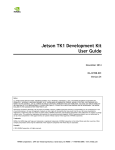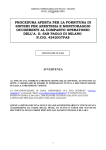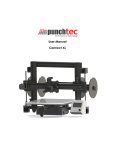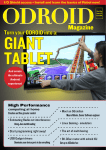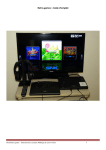Download For Dummies Blender, 2nd Edition
Transcript
Chapter 1 AL Discovering Blender ▶ Figuring out what Blender is and what it’s used for RI In This Chapter ▶ Understanding how the current version of Blender is influenced by its past MA TE ▶ Getting familiar with the Blender interface I GH TE D n the world of 3D modeling and animation software, programs are usually expensive — like, thousands-of-dollars-and-maybe-an-arm expensive. And there are some valid reasons for that cost. Software companies spend millions of dollars and countless hours developing these programs. And the large production companies that buy these programs for their staff make enough money to afford the high cost, or they hire programmers and write their own in-house software. CO PY RI But what about you and me, the little guys? We are the ambitious dreamers with big ideas, high motivation . . . and tight budgets. How can we bring our ideas to life and our stories to screen, even if only on our own computer monitors? Granted, we could shell out the cash (and hopefully keep our arms) for the expensive programs that the pros use. But even then, animation is a highly collaborative art, and it’s difficult to produce anything in a reasonable amount of time without some help. We need quality software and a strong community to work, grow, and evolve with. Fortunately, Blender can provide us with both of these things. This chapter is an introduction to Blender, its background, and its interface. Getting to Know Blender Blender is a free and open source 3D modeling and animation suite. Yikes! What a mouthful, huh? Put simply, Blender is a computer graphics program that allows you to produce high-quality still images and animations using three-dimensional geometry. If you’ve seen an animated feature film or watched a television show where they go behind the scenes and explain how they made an actor look like he’s being chased by a giant monster although 10 Part I: Wrapping Your Brain Around Blender he’s really just standing in a big green room, you’ve seen what can be done with 3D computer graphics. In the right hands, Blender is capable of producing this kind of work. With a little patience and dedication, your hands can be the right hands. One thing that makes Blender different and special compared to other comparable 3D software is the fact that it is free and open source. Being free and open source means that not only can you go to the Blender Web site (www. blender.org) and download the entire program right now without paying anything, but you can also freely download the source, or the code that makes up the program. For most programs, the source code is a heavily guarded and highly protected secret that only certain people (mostly programmers hired by the company that distributes the program) can see and modify. Because it’s open source, anybody can see Blender’s source code and make changes to it. The benefit is that instead of having a small group of paid programmers work on the program, Blender can be improved by programmers all over the world! Because of these strengths, Blender is an ideal program for small animation companies, freelance 3D artists, independent filmmakers, students beginning to learn about 3D computer graphics, and dedicated computer graphics hobbyists. Blender, like many other 3D computer graphics applications, has had a reputation for being difficult for new users to understand. At the same time, however, Blender is also known for allowing experienced users to bring their ideas to life quickly. Fortunately, with the help of this book and the recent improvements introduced in the latest version of Blender, that gap is becoming much easier to bridge. Discovering Blender’s Beginnings The Blender you know and love today wasn’t always free and open source. Blender is pretty unique in that it’s one of the few software applications that was “liberated” from proprietary control with the help of its user community. Originally, Blender was an internal production tool for an award-winning Dutch animation company called NeoGeo, founded in the late 1990s by Blender’s original (and still lead) developer, Ton Roosendaal. As interest in Blender grew, Ton spun off a new company, Not a Number (NaN), to market and sell Blender. Sadly, NaN was forced to shut its doors in 2002, despite Blender’s growing popularity. Ironically, this is where the story starts to get exciting. Chapter 1: Discovering Blender Even though NaN went under, Blender had developed quite a strong community, which was eager to find a way to keep its beloved little program from becoming lost and abandoned. In July 2002, Ton established a nonprofit organization called the Blender Foundation and arranged a deal with the original NaN investors to release Blender’s source to the Blender Foundation. The price tag was set at €100,000 (which at the time was about $100,000),. Initial estimations were that it would take as long as six months to one year to raise the necessary funds. Amazingly, the community was able to raise that money in a mere seven weeks. Because of the Blender community’s passion and willingness to put its money where its metaphorical mouth was, Blender was released under the GNU General Public License on October 13, 2002. With the source in the community’s hands, Blender had an avalanche of development and new features added to it in a very short time. Eight years later, the Blender community is larger and stronger than ever, and Blender is a powerful modern piece of software, competitive in terms of quality with similar software costing thousands of dollars. Not too shabby. Figure 1-1 shows screenshots of Blender from its early days to the Blender of today. Figure 1-1: Blender through the years: Blender 1.8 (top left), Blender 2.46 (top right), and the major changes apparent in the Blender of today (bottom). 11 12 Part I: Wrapping Your Brain Around Blender Making Open Movies and Games One cool thing about the programmers who write Blender is that many of them also use the program regularly. They’re writing code not just because they’re told to do it, but also because they want to improve Blender for their own purposes. Part of this motivation has to do with Blender’s open-source nature, but it also has to do with Blender’s history as an in-house tool built on direct artist input and sometimes written by the artists themselves. Seeking to get even more of this direct artist feedback to developers, the Blender Foundation launched Project Orange in 2005. The project’s purpose was to create an animated short movie using open-source tools, primarily Blender. A small team of artists was assembled in Amsterdam, in the Netherlands, and roughly seven months later, Elephants Dream premiered and was released as the first open movie, meaning that not only was it created by using open-source tools, but all the production files — 3D models, scenes, character rigs, and so on — were also released under a permissive and open Creative Commons Attribution license. If you don’t like Elephants Dream, you’re free to change it to your liking or use the files for something else entirely! How many movies give you that luxury? You can see the film and all the production files at www.elephantsdream.org. Due to the success of Orange, the Blender Institute was established in 2007 for the expressed purpose of having a permanent space to create open projects, as well as provide the service of training people in Blender. The first open project from the Blender Institute was Project Peach, which, following the model of Orange, assembled a team of artists who produced a short comedic animation called Big Buck Bunny. Like Elephants Dream, all production files for the Peach project were released under an open license. You can access them at www.bigbuckbunny.org. Not being inclined to rest on its laurels, the Blender Institute launched Project Apricot as the team creating Big Buck Bunny was wrapping up its production. Apricot was a project similar to Orange and Peach, but rather than create an animated movie, the goal here was to create a video game. The result of this was Yo Frankie!, a game based on Frankie, the leader squirrel character from the Big Buck Bunny project. And, of course, all the content is freely available at the Yo Frankie Web site, www.yofrankie.org, under a permissive Creative Commons license. With the completion of each project, the functionality and stability of Blender increased by a large degree. Orange brought improved animation tools, basic hair, and a node-based compositor. Peach provided enhanced particles for better hair and fur, optimizations for large scenes, improved rendering, and even better animation and rigging tools. Apricot revitalized Blender’s internal game engine, which extended to better real-time visuals when modeling and animating in Blender. Chapter 1: Discovering Blender And even as I wrote parts of this second edition of Blender For Dummies, artists at the Blender Institute were finishing up the latest open project, Project Durian. (A durian is a smelly Asian fruit with an exotic taste.) Durian is another short movie project, named Sintel, with the lofty goals of making Blender 2.5 production ready and adding features for epic scenes, including highly detailed sculpting, large environments, and highly detailed, high-resolution renders. You can see the film and access all the Durian project files at www.sintel.org. I’ve also included a copy of Sintel on the book’s companion DVD, and the color insert of this book has still images from a few of the open movie projects. All these projects continue to exhibit the strength of the Blender community. Each of them are financed in a large part by DVD presales from users who understand that regardless of the project’s final product, great improvements to Blender are the result, and everyone benefits from that. Getting to Know the Interface Probably one of the most daunting aspects of Blender for newcomers and longtime 3D professionals alike has been its unique and somewhat peculiar interface. It’s arguably the most controversial feature Blender has. In fact, at one time, merely calling the interface a feature would raise the blood pressure of some of you who tried using Blender in the past, but gave up in frustration when it did not behave as expected. Although the interface wasn’t the primary focus, the interface updates to Blender added in the 2.5 series of releases have made great strides toward alleviating that frustration. As a small example, when you first launch Blender, the splash image that appears is more functional now, providing you with quick links to online documentation as well as a list of recently opened files. Figure 1-2 shows the splash image you’re presented with when you start Blender for the first time. If you click anywhere other than the links provided by the splash image, the splash image goes away, and you’re greeted with Blender’s default scene, as shown in Figure 1-3. If you’re looking at the interface for the first time, you may think it appears pretty daunting. However, the purpose of this book is to help you get the hang of Blender, explaining some of the design decisions in the interface and ultimately allowing you to be productive. Who knows, you might even start to like it and wonder why other programs don’t work this way! 13 14 Part I: Wrapping Your Brain Around Blender Figure 1-2: The new and improved Blender splash image. Figure 1-3: The default Blender interface. Chapter 1: Discovering Blender An interface that stays out of your way The first thing to understand about Blender’s interface is its basic organization. Figure 1-3 displays a single Blender window. Each Blender window can consist of one or more areas that you can split, resize, and join at will. In nearly all cases, an area defines the space of an editor, such as the 3D View, where you actually make changes and modifications to your 3D scene. Each editor can include one or more regions that contain additional features or tools for using that editor. An example of a region that all editors have is a header region at the top or bottom of the editor that typically includes menus and buttons to give you access to features in that editor. Knowing this organizational structure, the next important thing to know is that Blender is designed to be as nonblocking and nonmodal as possible. Areas in Blender never overlap one another (nonblocking) and using one feature of Blender typically won’t restrict you from using any of the others (nonmodal). As an example, in most software, if you want to open a new file or save your project, a file browser dialog pops up. This dialog is an overlapping window that not only blocks things behind it from view, but usually also prevents you from making any changes to your file. This setup isn’t the case with Blender. In Blender, the file browser is an editor just like any other, and it makes perfect sense to be able to make a couple of tweaks to your scene before hitting the Save button. Figure 1-4 shows what it might look like to have a file browser open while you make tweaks. Figure 1-4: Doing those last couple of tweaks before finally saving (Model credit: Blender Foundation, Sintel). 15 16 Part I: Wrapping Your Brain Around Blender At first, working in a nonblocking, nonmodal interface may seem to be really restrictive. How do you see different types of editors? Can you see them at the same time? Everything looks like it’s nailed in place, so is it even possible to change anything? Fortunately, all these things are possible, and you get the benefit of never having your view of one area obstructed by another. Having an unobstructed workspace is a great way to be able to see at a glance what’s going on in your file. Furthermore, as of the Blender 2.5 development series, if you absolutely need multiple windows that can overlap, you can have them. For example, you might have two computer monitors that are different sizes, and you’d like a full-sized Blender window in each. I show you how to do task later in this chapter in the “Duplicating an area to a new window” section. Resizing an area You can modify and change all the areas in a Blender window in the same way: Change the size of an area by left-clicking the border between two areas and dragging it to a new position. This method increases the size of one area while reducing the size of those that adjoin it. If you have only one area in your Blender window, it’s exactly the same size as that window. To resize it, you need to either adjust the size of its parent Blender window or split a new area into that space. Splitting and removing areas While working in Blender, it’s pretty common that the default layout isn’t quite what you need to work efficiently. Sometimes you may need an additional 3D View, or you may want to see the UV/Image Editor in addition to the 3D View. To create either of these layout changes, you need to split an existing area into two. Splitting a new area doesn’t work like it used to in previous versions of Blender. In earlier versions, you’d split or join areas by right-clicking the border and choosing an option from a pop-up menu. As of Blender 2.5, a new system uses the corners at the bottom left and top right of any area. These corner widgets are marked as a triangular region indicated by diagonal lines. To split any area into two, use the following steps: 1. Left-click one of the corner widgets and drag your mouse cursor away from the area’s border. 2. Drag your mouse cursor left or right to split the area vertically. Dragging it up or down splits the area horizontally. As you drag your mouse, the areas update in real time so that you can see the result of the split while you’re working. To cancel the operation, right-click or press Esc. Chapter 1: Discovering Blender If you want to remove an area, the process is similar. Rather than splitting an area in two, you’re joining two areas together. So instead of left-clicking the corner widget and dragging your mouse cursor away from the area border, drag it toward the border of the area you want to join with. This action darkens the area your mouse is in and draws an arrow to indicate which area you want to remove. Figure 1-5 shows the basic steps for splitting and joining areas. Duplicating an area to a new window In addition to the new way of splitting and joining areas, the Blender developers have also introduced a brand-new feature in the 2.5 series via corner widgets. You now have the ability to take any area and duplicate it to a new Blender window. You can move that window to a separate monitor (if you have one), or it can overlap your original Blender window. And within this new Blender window, you can split the duplicated area into additional ones as you like. This area duplication feature is a slight violation of Blender’s nonoverlapping principles, but the benefits it provides for users with multiple computer screens make it very worthwhile. To take advantage of this feature, follow these steps: 1. Shift+left-click one of the corner widgets in an area and drag your mouse cursor away from it. This step duplicates the area you clicked in and creates a new Blender window to contain it. You can also achieve this effect from the menus in the header region of some editors by choosing View➪Duplicate Area into New Window. 2. Close the additional Blender window by clicking the close button that your operating system adds to the border of the window. All editors in Blender areas have a horizontal region called the header running along either the top or bottom of the editor. The header usually features specialized menus or buttons that are specific to the editor you’re using. Here are some ways you can customize the header: ✓ Hide the header. If you drag the seam all the way to the area border, then the header becomes hidden, leaving only a small plus icon (+) in the corner of the area. If the header is at the bottom of the editor, the plus icon appears at the bottom right. If the header appears at the top, it’s at the top left. Left-click this icon, and the header reappears. ✓ Change the location of the header. You can also change the location of the header to either the top or bottom of the editor it belongs to. To do so, right-click the header and choose Flip to Top (or Bottom, depending on where your header currently is). 17 18 Part I: Wrapping Your Brain Around Blender Create a new area Remove an area Figure 1-5: Creating a new area and then removing that area. Maximizing an area When working in Blender, you also occasionally need to maximize an area. Maximizing an area is particularly useful when you’re working on a model or scene and you just want to get all the other areas out of your way so that you can use as much screen real estate as possible. To maximize any area, hover your mouse cursor over it and press Shift+spacebar. You can toggle back to the tiled screen layout by pressing Shift+spacebar again. These options are available in almost all editor types by choosing View➪Toggle Full Screen from that editor’s header or by rightclicking the header and choosing Maximize Area from the menu that appears. If the area is already maximized, then the menu item will say Tile Area.











